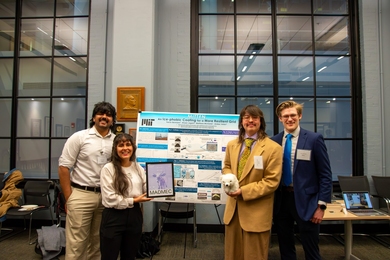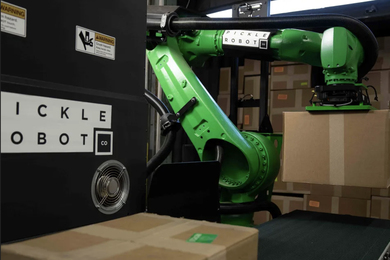MIT's new cogeneration plant powered up Monday morning at 9am, marking its first official day as MIT's campus power source. That day it provided more than 18 Megawatts of energy capacity, the full complement needed for a cool day at the end of summer.
The cogeneration plant will now provide MIT's main campus buildings with all needed steam heat and cooling and 75 percent of their electricity needs around the clock. Construction was started in spring 1993, and the plant has been in various stages of testing over the last several months as workers made final adjustments preparing for operations to be turned over from the vendor MIT hired to install the equipment to MIT employees, who are now fully trained. During that time, MIT was intermittently using electricity generated by the plant.
To meet MIT's electric needs beyond the 75 percent provided by the new plant, MIT will continue to buy power from the Cambridge Electric Company (CELCO). This will cover MIT during times when the MIT generator is out of service or the peak demand exceeds the generator capacity, and will also provide power to the buildings on MIT's periphery. The new plant will generate approximately 20 megawatts of electricity.
"Cogeneration, the use of one fuel to generate two forms of energy, is a an old concept, but an important one for us to make use of," said Victoria V. Sirianni, director of Physical Plant. In the MIT project, the generator will be powered by a natural-gas turbine engine to produce electricity. The resulting hot exhaust gases will be used to produce steam in a heat-recovery generator. "This energy-efficient technology, where one fuel fulfills two purposes, is a good investment in the Institute's future," she said. "Cogeneration is 18 percent more efficient than generating electricity and steam independently."
The gas-fired cogeneration plant will reduce MIT's pollutant emissions by 45 percent, to a level equivalent to reducing vehicle commutes to and from Cambridge by 13,000 average round trips per day, while at the same time saving MIT money on utilities.
When MIT first moved to Cambridge, it was powered by its own cogeneration plant, according to Tom Shepherd, who retired as MIT's associate director of Physical Plant in January 1993 but played a major role in establishing the new cogeneration plant. MIT operated solely under its own power until the 1940s.
In the 1960s when MIT was using outside power, its old cogeneration plant provided invaluable aid. "In the '65 blackout of the East Coast, the city of Cambridge didn't have any capacity to restart their power. MIT fired up one of its original oil-powered cogeneration machines and backfed electricity to Cambridge Electric to start their generators," Mr. Shepherd said.
Many people in Physical Plant were involved in making the transition to cogeneration. In particular, Roger Moore, superintendent of utilities, worked on the cogeneration project for eight years. Allen J. (Joe) Cavicchi, project manager for the last two years, left his role this summer to pursue full-time study for an advanced degree at MIT.
MIT commissioned Parsons Main, Inc., of Boston to design the facility, provide construction assistance and start-up services. The work involved replacing two of the five existing oil-fueled boilers with new cogeneration units and upgrading the others, which will be used as backup units.
"It's been very long and challenging process," Ms. Sirianni said. "We had the difficult prospect of installing the new equipment into our existing plant, particularly with the complete rebuilding of our primary electrical system."
A version of this article appeared in MIT Tech Talk on September 13, 1995.





